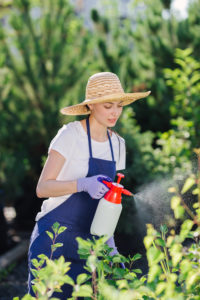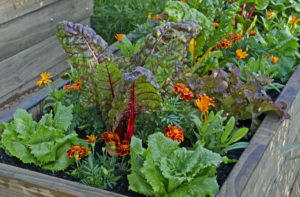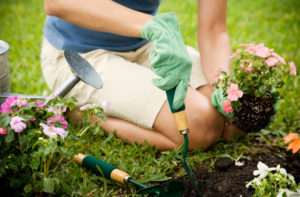With many of us spending more time at home this Spring than normal, many patients have been asking some gardening questions. How to garden without hurting one’s back? What are the healthiest vegetables to plant? What are healthy ways to control weeds and fertilize? So, if you have some extra time on your hands and you want to enjoy a healthy activity outside, plant a garden. Here are some helpful tips.
1. First time gardening?
If this is your first garden, don’t bite off more than you can chew…or hoe. Start off with a garden no larger than 8’ x 10’. It’s important to choose a location that receives as much sun as possible throughout the day, is relatively flat, and away from large trees.
2. Ask yourself what you want to plant.
I prefer to only grow plants that I like to eat. Focus on the healthiest vegetables and the “dirtiest” vegetables, those that are most commonly sprayed with cancer-causing fertilizers and pesticides (kale, spinach, strawberries, bell peppers, celery, tomatoes, etc).
Here are some specific examples of great, easy to grow, vegetables:
Broccoli, peas, beans (especially dry beans), brussel sprouts, tomatoes, red bell peppers, beets, leaf amaranth, carrots, and leafy greens.
Also consider these great “companion herbs” to grow alongside your other veggies: basil, chamomile, chive, cilantro, dill, garlic, mint, rosemary, sage, and tarragon.
3. Try to keep it organic.
Organic gardening can be a bit more labor intensive but it is often more economical. Many homemade fertilizers, insecticides, and weed killers can be made with cheap household products. Here are a few of our favorites.
Beer Fertilizer
- 1 cup Epsom salt
- 1 can of beer
- 1 cup of ammonia
Dissolve the Epsom salts in 2 cups of warm water. Add the Epsom salt and a can of beer into your garden sprayer or 3 gallon watering can. Add the ammonia right before use to maximize its effectiveness.

Homemade All-Purpose Insecticide Spray
- 15 cloves garlic
- 1 onion
- 3 cayenne peppers
- 1/2 teaspoon liquid Castile soap
- 4 cups water
Blend in a blender and use with a spray bottle.
Natural Weed Killer Recipe
- 1 gallon white vinegar—gardening variety works best as it is 20% acetic acid
- 1 cup salt— Epsom salt or rock salt works great but you can use table salt
- 1 tablespoon liquid dish soap
Combine ingredients in a spray bottle and treat weeds at the sunniest time of day for best results. This spray will not only kill the weeds, it will prevent them from returning. I would suggest spraying on a sunny day, repeat 3 days later for best results.
Note: If you want to replant the area after the weeds have been killed or you are spraying near delicate shrubs or concrete, try omitting the salt. Salt will leach into the soil and prevent new growth of plants and/or etch the concrete.
4. Try planting flowers in with your vegetables.
If you’re still growing flowers and vegetables on opposite sides of your yard, it’s time to rethink your garden plan. Companion planting flowers and vegetables in the same beds is a strategy professional growers use to boost yields and keep crops healthy. The most important reason to grow flowers in your vegetable bed is to attract native bees and other beneficial insects. Without bees stopping by your garden to snack on nectar and swap pollen around, you’re going to have a pretty disappointing crop.
 In order to maximize this strategy, pay attention to bloom time: you have to select flowers that will bloom at the same time as your veggie crops. If the type you planted doesn’t blossom until two weeks after your peas finish flowering, your peas are out of luck.
In order to maximize this strategy, pay attention to bloom time: you have to select flowers that will bloom at the same time as your veggie crops. If the type you planted doesn’t blossom until two weeks after your peas finish flowering, your peas are out of luck.
Try to sprinkle flowers throughout the garden rather than planting them in one clump. How you do it is really up to you. You can plant a row of veggies followed by a row of flowers, or you can interspace them within the same row. Consider getting strategic and using flowers to break up a row to indicate where your sweet peppers end and your hot peppers begin. Or, plant flowers to form a border around the outside of the bed. I would suggest choosing mostly low-growing flowers. However, some crops (like lettuces) might benefit from a little shade during the summer months, so occasionally it makes sense to go with a taller variety.
5. Keep your back healthy.
Gardening is usually one of the first activities of the season where we subject ourselves to sudden bursts of activity and really put our backs at risk. With spring in the air, you look forward to getting out in the garden but you’re not looking forward to feeling sore after all the kneeling, pulling, leaning, and twisting.
Begin with a great warm up without static stretching. As with any form of exercise, a great warm up is essential to reducing soreness and injury. Take a short brisk walk first to warm up your muscles and get your body in work mode. Next, perform some shallow squats and lunges. If you need to hold onto a doorway or tree to keep good form. Focus on increasing hip range of motion with each repetition. This will improve your form when your working in the garden.
Break up your gardening tasks by not trying to get everything done in one session. Alternating tasks is a good way to break up the repetitive motions.
When you are digging make sure you keep the shovel in front of you and avoid twisting motions. If you need to get to an area on the side, re-position yourself to keep the shovel in line with your body. The same goes for raking – pull the rake towards your body, not off to the sides.

Don’t forget to kneel, squat, or lunge do not bend at the waist. The whole purpose of the warm-up was to help you move better through the hips, so that you avoid bending when you are in the garden. When you bend for a prolonged time, the ligaments in your back are overstretched. To avoid this from happening, keep your back straight in a more neutral position hinging at your hips when you pick weeds, lift bags of soil, and even when you are pulling the hose through the garden.
Last, it is very important to make sure you take breaks to stand up straight and stretch about every 15-30 minutes. Bring a water bottle outside with you to stay hydrated, especially on warmer days.
Prevention is key! Similar to how a pre-emergent weed killer prevents weeds from sprouting and taking over your lawn, a chiropractic adjustment can prevent a sore back from becoming an injured back. Soreness for 12-24 hours is just a reminder that you did some work, if that soreness persists, you need to get adjusted fast. The compensation patterns associated with gardening, bending, and lifting activities can create the right environment for some of the worst low back injuries. Not only can an adjustment help reduce the pain, but the self-help advice that we can give will be very important in minimizing any further damage. Email or call us to schedule an appointment. Stay healthy and let this year be fruitful in the garden and in your life!

Daryl C. Rich, D.C., C.S.C.S.






